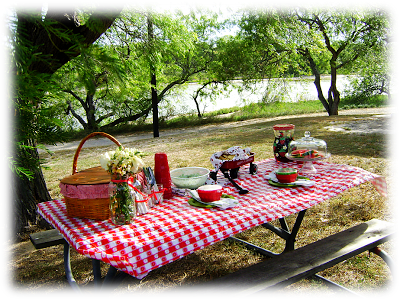
by sbouie | Jul 17, 2016
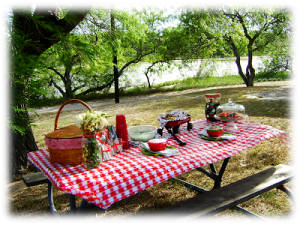 Picnics are a great opportunity for families to enjoy the great outdoors. It provides time to experience special bonding while enjoying the fresh air and delicious food. However, we should always be cautious of food borne illness.
Picnics are a great opportunity for families to enjoy the great outdoors. It provides time to experience special bonding while enjoying the fresh air and delicious food. However, we should always be cautious of food borne illness.
Let’s keep food and your family safe from the start! Whether the foods are from home, a store, or restaurant, follow the simple rules of keeping hot foods hot and cold foods cold. Remember that bacteria can grow fast at temperatures between 40°F and 140°F – the Danger Zone. Eat and promptly chill leftovers within two hours, and if the outside air temperature is above 90°F, do so within one hour.
If you plan to cook on site, make sure raw meats are packed well and are separated from ready-to-eat foods to prevent any cross-contamination. All perishable foods must be kept cold (40°F or below) in insulated boxes with enough ice, frozen gel packs, or other cold source, such as a container of frozen water. If possible, bring an appliance thermometer along to monitor the box temperature. When you grill the meat, make sure it is cooked to the right temperature. Also, bring enough potable water if none will be available at the site, and pack clean, wet, disposable cloths or moist towelettes and paper towels for cleaning hands and surfaces. Keep your tailgate party fun and bacteria-free for your family’s well-being!
Besides the food, plan your time. Plan some fun outdoor games that the entire family will enjoy. You may even plan a nature walk, name the cloud’s shape, or be creative and create your own activity. Whatever you plan, always involve the entire family. Every family member should be included.
This is the best time to say “no electronic devices.” This is time for the family to have face time without interruptions – time to talk to each other and grow closer. Picnic time translates “it’s family time” – eating outside in the fresh air and enjoying your family.
Reference: Food Safety and Tailgating, Amy Simonne. EDIS Publication #FAR8712
by Marjorie Moore | Jun 1, 2016
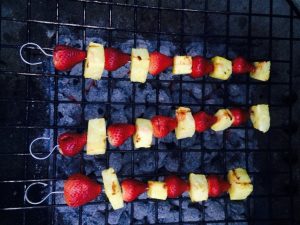 Did you know that the majority of people grill on July 4th (82%), followed by Birthdays (72%), Labor Day (70%), Memorial Day (62%) and the Super Bowl (30%)? Grilling is an all-time favorite for many households and now that the weather is warming, more families are using their grills to prepare family meals.
Did you know that the majority of people grill on July 4th (82%), followed by Birthdays (72%), Labor Day (70%), Memorial Day (62%) and the Super Bowl (30%)? Grilling is an all-time favorite for many households and now that the weather is warming, more families are using their grills to prepare family meals.
Enjoy grilling this season but be sure to be safe to avoid accidents. According to the National Fire Protection Association between 2007-2011, gas grills were involved in an annual average of 7,200 home fires, while charcoal or other solid-fueled grills were responsible for an annual average of 1,400 home fires.
Whether you have a charcoal, gas or in-door grill, become the grill master in your house by carefully reading the manufacturer’s operating and maintenance instructions for your family’s grill. Follow these important tips to help you and your family use your grill safely.
- Regularly remove grease or fat buildup from the racks/grates to reduce chances of having a fire. Thoroughly clean your grill at least once a year so it will last longer.
- For charcoal grills, look at the new safety label on the charcoal bags. Charcoal is hard to ignite so people are often tempted to use ready-to-light charcoal or charcoal fluid. These products seem to make lighting charcoal easier, but they will introduce a lot of chemicals and sometimes leave a chemical taste on the food. Always, follow the manufacturer’s instructions and never use lighter fluid after the fire is started.
- Remember to only use your gas and charcoal grills outside.
- Place your gas grill at least 10 feet away from your house or any building. Never grill in the garage, breezeway, carport, porch, or under a surface that can catch fire.
- Keep a fire extinguisher accessible in the event of a fire.
- Always keep food safety in mind when grilling and use different dishes and utensils for raw meat and cooked meat. By putting cooked food on plates that held raw meat, you are cross-contaminating the food. Any bacteria present in the raw meat could be reintroduced to the cooked food.
- Cold food should be kept cold until ready to grill – never leave raw meat, poultry, or any perishable food out at room temperature for more than two hours.
- Don’t forget to use a thermometer, especially when cooking meat, poultry and fish. Raw meat can contain harmful bacteria and other pathogens, which can cause food poisoning if ingested. A meat thermometer is an especially important tool and will help guard against food poisoning. The color of meat and poultry is not a good indicator of safety.
For more information, check out our grilling factsheet. http://bay.ifas.ufl.edu/fnc/files/2011/09/Grilling-safety.pdf
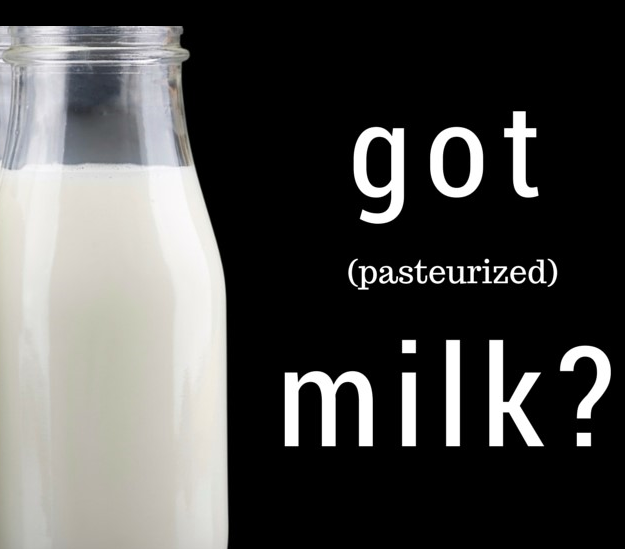
by Angela Hinkle | May 19, 2016
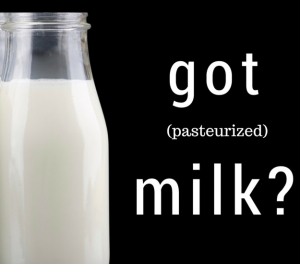 “Milk and milk products provide a wealth of nutrition benefits. But raw milk can harbor dangerous microorganisms that can pose serious health risks to you and your family. According to an analysis by the Centers for Disease Control and Prevention (CDC), between 1993 and 2006, more than 1,500 people in the United States became sick from drinking raw milk or eating cheese made from raw milk. In addition, CDC reported that unpasteurized milk is 150 times more likely to cause foodborne illness and results in 13 times more hospitalizations than illnesses involving pasteurized dairy products.”
“Milk and milk products provide a wealth of nutrition benefits. But raw milk can harbor dangerous microorganisms that can pose serious health risks to you and your family. According to an analysis by the Centers for Disease Control and Prevention (CDC), between 1993 and 2006, more than 1,500 people in the United States became sick from drinking raw milk or eating cheese made from raw milk. In addition, CDC reported that unpasteurized milk is 150 times more likely to cause foodborne illness and results in 13 times more hospitalizations than illnesses involving pasteurized dairy products.”
This is an excerpt from the U.S. Food and Drug Administration Protecting and Promoting Your Health website http://www.fda.gov/Food/ResourcesForYou/Consumers/ucm079516.htm. By reading the information and watching the video on this site, you can better understand the dangers of raw milk and how it can affect your family.
Milk is good for you and it tastes great. Just remember to drink it responsibly and safely.

by jbreslawski | Mar 11, 2016
 It seems that everywhere you look, an egg hunt is being advertised, egg dye kits are on every corner in the store, and the Internet is a-buzz with cool decorating ideas. Keep in mind this season that this fun family activity could turn rotten if you forget food safety.
It seems that everywhere you look, an egg hunt is being advertised, egg dye kits are on every corner in the store, and the Internet is a-buzz with cool decorating ideas. Keep in mind this season that this fun family activity could turn rotten if you forget food safety.
Outbreaks of foodborne illness, especially salmonella, have been associated with the improper preparation and storage of eggs. Salmonella is not something you want to remember when you think back to memories of decorating and hunting eggs in the spring.
Common symptoms of salmonella include nausea, vomiting, abdominal cramps, diarrhea, fever, and headache. Children are one population most susceptible to foodborne illness.
There is no reason to worry about potential food safety hazards associated with your holiday eggs as long as you remember to follow these guidelines:
- Clean and sanitize your hands, preparation area, and utensils before, during, and after the cooking process.
- Use eggs that are clean and free of cracks and leaks.
- Cook eggs completely – no rushing or short cuts. If you don’t have the time, pick another day to do it.
- Use only food-grade dyes; these include food coloring and dye sold in egg dye kits. Use beet juice, blueberry juice, etc. as alternatives to artificial dye.
- Refrigerate eggs as soon as you are finished decorating or, if decorating later, after cooking and drying.
- The refrigerator door is the warmest spot in your fridge; store eggs in the carton in the main compartment, not in the door.
- Toss eggs that have been out of the refrigerator for more than 2 hours. If eggs are not “found” or eaten, within this time, make the sacrifice and throw them away (of course, do this while the kids aren’t looking.)
- When hiding eggs for a hunt, keep them in areas that are clean, free of dirt, and away from pets or pests. Consider decorating one set for hunting and another for eating.
- Hard-boiled eggs are safe for up to one week with proper cooking, storing, and handling procedures.
Keep these guidelines in mind for an “egg”cellent holiday with family, friends, and fun!
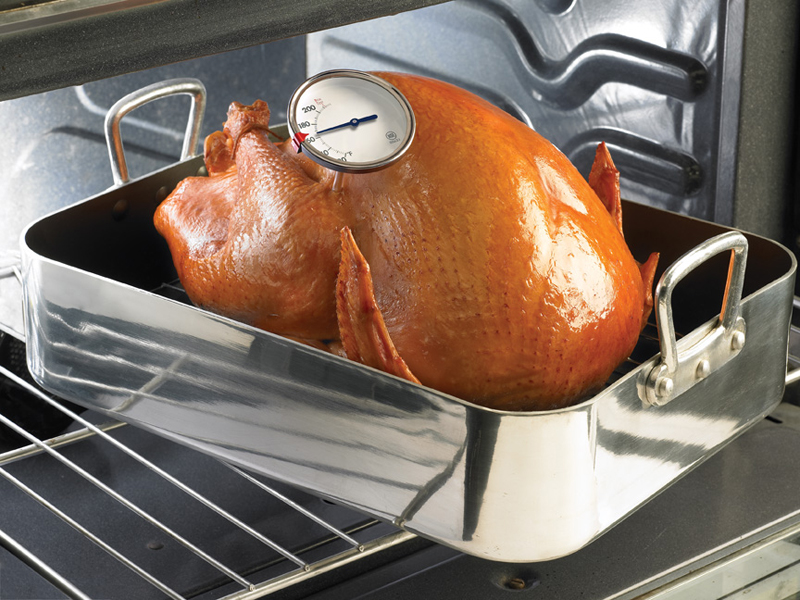
by Judy Corbus | Nov 27, 2015
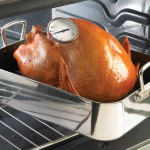 Have questions about safely preparing your holiday meal? Refer to this quick reference for answers to common questions this time of year:
Have questions about safely preparing your holiday meal? Refer to this quick reference for answers to common questions this time of year:
Q. Approximately how long should you allow for thawing a frozen turkey in the refrigerator?
A. 24 hours per each 4 – 5 pounds of turkey. In it’s original wrapper, place the frozen bird in the refrigerator (40˚F or below). To prevent cross contamination, be sure to place the turkey in a container. A thawed turkey can remain in the refrigerator for 1 – 2 days.
Q. How long should I cook the turkey?
A.
COOKING TIME – UNSTUFFED
Size of Turkey Estimated Time to Reach 165˚F
8 – 12 pounds 2 ¾ – 3 hours
12 – 14 pounds 3 – 3¾ hours
14 – 18 pounds 3 ¾ – 4 ¼ hours
18 – 20 pounds 4 ¼ – 4 ½ hours
20 – 24 pounds 4 ½ – 5 hours
COOKING TIME – STUFFED
Size of Turkey Estimated Time to Reach 165˚F
8 – 12 pounds 3 – 3 ½ hours
12 – 14 pounds 3 ½ – 4 hours
14 – 18 pounds 4 – 4 ¼ hours
18 – 20 pounds 4¼ – 4 ¾ hours
20 – 24 pounds 4 ¾ – 5 ¼ hours
Q. What is a safe internal temperature for cooking a whole turkey?
A. 165˚F. Use a food thermometer to check the internal temperature of the turkey. Insert the thermometer in the innermost part of the thigh and wing and the thickest part of the breast, making sure not to touch the bone. All turkey meat, including any that remains pink, is safe to eat as soon as all parts reach at least 165˚F. Let the turkey stand 20 minutes after removing from the oven. Remove any stuffing and carve the turkey.
Q. What is the recommended temperature for stuffing?
A. 165˚F. The stuffing should reach 165˚F whether cooked inside the bird or in a separate dish.
Q. I want to stuff the turkey. How do I do this safely?
A.
1. Cook any raw meat, poultry, or shellfish you plan to use before stuffing the turkey. Do not mix wet and dry ingredients until just before stuffing the turkey cavity; wet ingredients can be prepared ahead of time and refrigerated.
2. Spoon stuffing directly into the cavity right after preparation. Stuff loosely – plan for ¾ cup of stuffing per pound. The stuffing should be moist, not dry – bacteria is destroyed more quickly by heat in a moist environment. Do NOT stuff turkeys to be grilled, smoked, fried, or microwaved.
3. Cook the turkey immediately in an oven no lower than 325˚F.
4. Use a food thermometer to make sure the temperature of the turkey AND the center of the stuffing have reached a safe minimum internal temperature of 165˚F.
5. Let the cooked turkey rest for 20 minutes before removing the stuffing and carving.
Q. How long can I keep leftovers?
A. Refrigerate all leftovers within two hours after cooking. Divide cooked foods into shallow containers; this allows the center of the food to cool more quickly and evenly. Use within 3-4 days or freeze for longer storage. Be sure to reheat hot foods to at least 165˚F; sauces, soups, and gravies should be heated to a rolling boil.
For more information about holiday foods and food safety (in English and Spanish), call: USDA Meat and Poultry Hotline, 1-888-MPHotline (1-888-674-6854) www.fsis.usda.gov
Source: Avoid Guessing About Holiday Food Safety, University of Nebraska-Lincoln Extension.

by Dorothy C. Lee | Oct 28, 2015
 It’s that time of the year! The holidays are upon us. A time when our thoughts turn to family, friends, celebrations, holiday feasts, and, yes, leftovers.
It’s that time of the year! The holidays are upon us. A time when our thoughts turn to family, friends, celebrations, holiday feasts, and, yes, leftovers.
Holiday meal leftovers can be just as delectable as the original feast. The challenge is after dinner, and guarding against left-out leftovers. It requires special attention to safe food handling. Even if you have followed all the food safety recommendations, the potential for foodborne illness can still exist. Bacteria that causes foodborne illnesses grows rapidly at room temperature and above.
In the holiday frenzy, basic principles can often be overlooked. Here are some food safety tips to help ensure that your holiday leftovers are safe and delicious the second time around.
Food safety doesn’t end after the meal is prepared. The challenge is also safe storage of leftovers. Reheating will not always destroy harmful bacteria. Better to keep bacteria from multiplying in the first place.
Prepared foods should be refrigerated after no more than two hours of being left out at room temperature. Leftovers should be consumed or frozen within four days of cooking.
Remember the rule: Keep hot foods hot and cold foods cold. Bacteria can multiply rapidly between 40°F and 140°F. Don’t leave that turkey out for nibblers. Take the dressing out and slice the meat from the turkey carcass. Store the stuffing, meat, and any other leftover gravy, mashed potatoes or other side dishes, all in separate containers. Date each container and refrigerate or freeze.
Frozen turkey will maintain its quality in the freezer for up to four months; stuffing and gravy for one month; and cooked dishes prepared from leftover turkey will freeze well for up to six months.
Keeping in mind these tips for keeping holiday leftovers safe could keep your holiday feast from turning into a holiday disaster.
If you would like more information, please call the USDA Meat and Poultry / Food Safety Hotline: 1-888-674-6854 , or check out the food safety website, www.foodsafety.gov.
, or check out the food safety website, www.foodsafety.gov.
For further information contact:
Dorothy C. Lee, C.F.C.S.
UF/IFAS Extension Escambia County
3740 Stefani Road
Cantonment, FL 32533-7792
(850) 475-5230
dclee@ufl.edu
For additional information, go to the University of Florida Solutions for Your Life website, http://www.SolutionsForYourLife.com

 Picnics are a great opportunity for families to enjoy the great outdoors. It provides time to experience special bonding while enjoying the fresh air and delicious food. However, we should always be cautious of food borne illness.
Picnics are a great opportunity for families to enjoy the great outdoors. It provides time to experience special bonding while enjoying the fresh air and delicious food. However, we should always be cautious of food borne illness.







